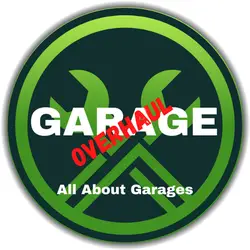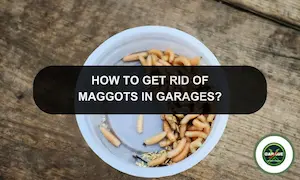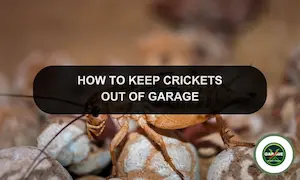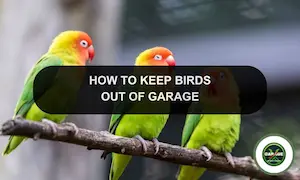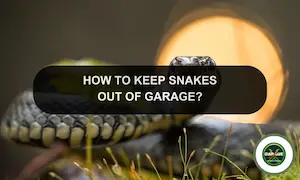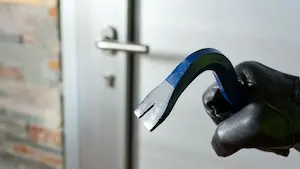How To Keep Pests Out Of Garage: Keep Bugs, Vermin and Other Creepy Crawlies Out
This post contains affiliate links.
This post contains affiliate links.
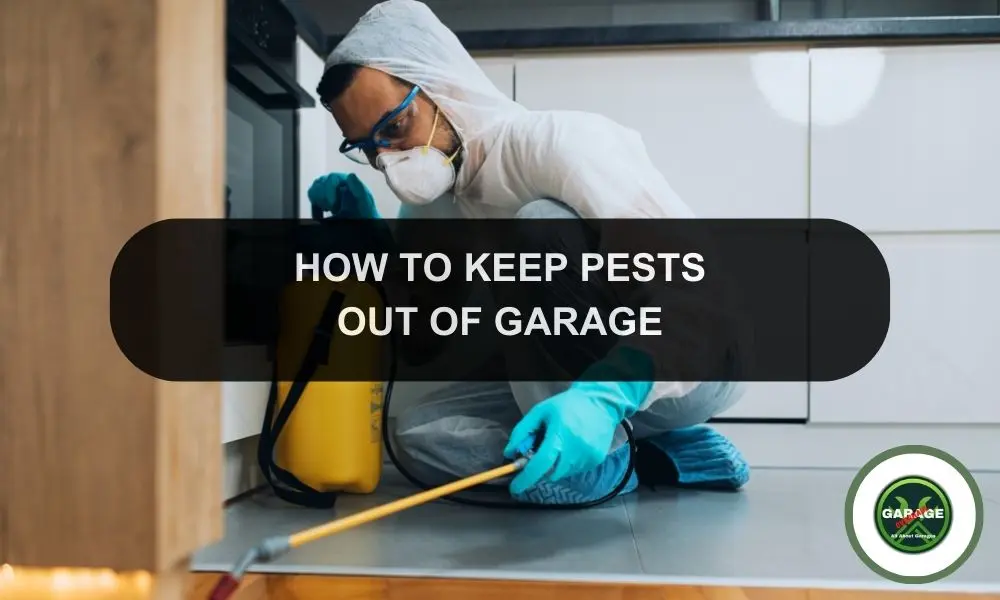
You may have spent much time and effort ensuring your garage is furnished and improved. One of the biggest worries, however, is that pests, bugs, and vermin may be able to find their way into your garage and ruin your hard work. How to keep pests out of the garage?
To keep pests out of garage, you can:
- Seal Entry Points
- Regular Cleaning
- Proper Storage
- Use Traps
- Maintain Your Garage Door
- Pest Control Products
- Professional Pest Control
This post explores how you can keep pests out of your garage. We also look at the common pests that could make their way to your garage and how they can damage it. Finally, we explore how you can improve your garage door to keep pests from coming into your garage.
Why Do Garage Bugs And Pests Love Your Garage?
Garage bugs and pests seem to have a particular fondness for our garages, turning these spaces into their own little sanctuaries.
Here are some reasons why your garage might be the hotspot for these uninvited guests.
Shelter From Predator & Harsh Weather
First off, your garage offers a haven from the outside world, providing pests with shelter from predators and harsh weather conditions.
The garage space, often less frequented by humans, becomes a safe breeding ground for pests and bugs:
- Spiders spin their webs in corners,
- rodents find cozy spots to nest on the floor and
- Snakes curl up on the corners or the beams of your garage.
Lots Of Nesting Materials
The items you store in your garage act like magnets for pests. Cardboard boxes, old furniture, and seasonal decorations provide perfect hiding and nesting spots, especially for spiders and small rodents.

Often undisturbed for long periods, these items offer a peaceful habitat for pests to thrive.
Easy Access: Poor Garage Door Maintenance
Then there’s the issue of accessibility. Cracks and gaps around garage doors or windows are like open doors for pests. Even the smallest opening can allow bugs and rodents to enter your garage.
Regular maintenance, such as applying silicone caulk to seal these gaps, can help keep pests at bay. But it’s a constant battle to identify and close every potential entry point.
Dampness And Moisture
Moisture is another big draw for pests, particularly sowbugs, and insects that thrive in damp environments. If your garage tends to be humid or has leaks, it could be attracting these moisture-loving pests.
Proper ventilation and fixing leaks can help reduce the humidity, making your garage less inviting to pests.
Clutter
Clutter is a big factor when it comes to pest control. A cluttered garage, with items lying around, provides numerous hiding spots and nesting areas for pests.
Regular cleaning and decluttering can significantly reduce the risk of a pest infestation. It’s essential to keep your garage clean and organized to deter pests.
What Are The Common Garage Bugs And Pests?
Garages can unwittingly become sanctuaries for various bugs and pests. These uninvited guests find the conditions in most garages ideal for making themselves at home.
Let’s look at some common garage invaders:
Spiders
Spiders are attracted to garages as these areas provide a perfect blend of shelter, warmth, and food sources, such as insects. They prefer the undisturbed corners, ceilings, and clutter that garages often offer, making it easy for them to spin webs and catch prey.
Spiders typically nest in secluded spots where their webs won’t be disturbed, like:
- behind storage boxes,
- in window frames or
- under workbenches.
These locations provide a stable environment for laying eggs and offer protection from predators. The availability of insects attracted to the garage further encourages spiders to settle and multiply, turning the garage into an ideal habitat for them to thrive.
Read the thorough guide here on how the get rid of spiders
Mice and other small rodents
Mice, rats, and other rodents find garages appealing for their warmth, shelter, and readily available food sources, such as garbage or stored pantry items. These creatures can easily squeeze through tiny cracks or holes to gain entry.
Once inside, they often nest in secluded areas like behind walls, storage boxes, or amongst clutter, where they’re less likely to be disturbed. They use all sorts of materials to build their nest, like:
- shredded paper,
- fabric, or
- insulation.
The garage provides a perfect breeding ground, offering protection from predators and harsh outdoor conditions, allowing rodent populations to grow unnoticed.
Sowbugs
Also known as pillbugs, they thrive in moist environments. If your garage tends to be damp, it might become a breeding ground for these pests.
Improving ventilation and addressing moisture issues can make your garage less inviting to sowbugs.
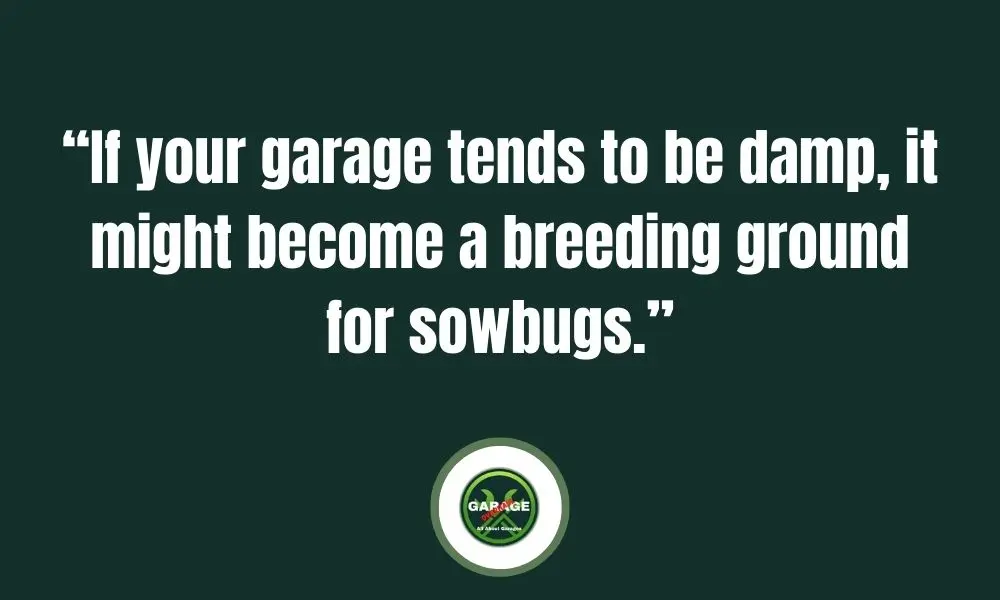
Ants
Ants are drawn to garages for food, water, and shelter. They’re particularly attracted to sugary spills, pet food, or garbage stored inside. Garages often offer entry through tiny cracks in walls, floors, or around doors, allowing ants easy access.
Once inside, they can establish nests in:
- walls,
- under floors or in
- any undisturbed corner.
Ant colonies in garages can quickly grow, with worker ants constantly foraging for food and returning it to the nest. This can lead to a persistent problem, as the garage provides a stable environment for the ants to thrive and multiply.
Wasps and bees
These flying menace choose your garage as a nesting site, especially if there are ample entry points.
Keeping doors and windows sealed when not in use and monitoring for early signs of nests can prevent larger infestations.
Cockroaches
Cockroaches are attracted to garages due to the abundance of hiding spots, warmth, and available food sources like garbage, pet food, or spills. They prefer dark, moist environments, making cluttered garages with poor ventilation ideal.
Cockroaches can nest in various garage locations, including:
- cardboard boxes,
- cracks in walls or
- behind stored items.
Once nested, they start laying their eggs in discreet crevices. Their ability to feed on almost anything and their preference for warm, hidden areas enable them to thrive and multiply in garage environments, often going unnoticed until their numbers significantly increase.
Read the thorough guide here on how the get rid of cockroaches
Flies & Maggots
Flies and maggots are attracted to garages primarily due to things such as decaying organic matter, which serves as an ideal food source and breeding ground. This includes garbage, pet waste, and any rotting food that may be stored or forgotten in the garage.
They can enter through open doors or tiny cracks and, once inside, find plenty of dark and damp spots conducive to laying eggs. These locations often include:
- garbage bins,
- corners filled with debris or
- under shelving units.
Maggots, the larvae stage of flies, thrive in these conditions, feeding on the decaying matter until they mature into flies, perpetuating the cycle and increasing their population within the garage.
Read the thorough guides on how the get rid of flies or maggots
Centipedes
Perhaps less common, you can find them in damp garage environments where they hunt other small insects. Like sowbugs, they prefer moist conditions, so managing humidity in your garage can help keep them away.
Snakes
Snakes are drawn to garages for shelter, warmth, and a potential food supply. They sneak in through small openings or gaps around doors and windows, looking for quiet, undisturbed spots to nest.
Once inside, they might settle in dark corners, under clutter, or in less frequented areas where they can hide and hunt unnoticed.
Their nesting behavior involves curling up in these secluded spots, making nests out of existing debris or materials in the garage, and creating a hidden sanctuary within your space.
Read the thorough guide here on how the get rid of snakes
How Can Bugs And Pests Damage Your Garage?
Bugs and pests in the garage are more than just a nuisance. If uncontrolled, they can cause significant damage to your garage space and the items stored within. Understanding how these unwelcome visitors impact your garage is the first step in combating them effectively.
Wood Damage
Wood damage is common, especially with termites and carpenter ants entering your garage. These pests burrow into wooden garage structures and stored items, compromising their integrity.
Over time, wood damage can lead to costly repairs and replacements for:
- garage doors,
- frames, and even
- shelving units.
Wiring Problems
Wiring problems can arise when rodents, such as mice and rats, take up residence in your garage. They have a penchant for chewing on wires, which can not only damage garage door openers and lighting fixtures but also pose significant fire hazards.
Regular inspections on the wiring and piping system can help identify, diagnose, and rectify these issues before they escalate.
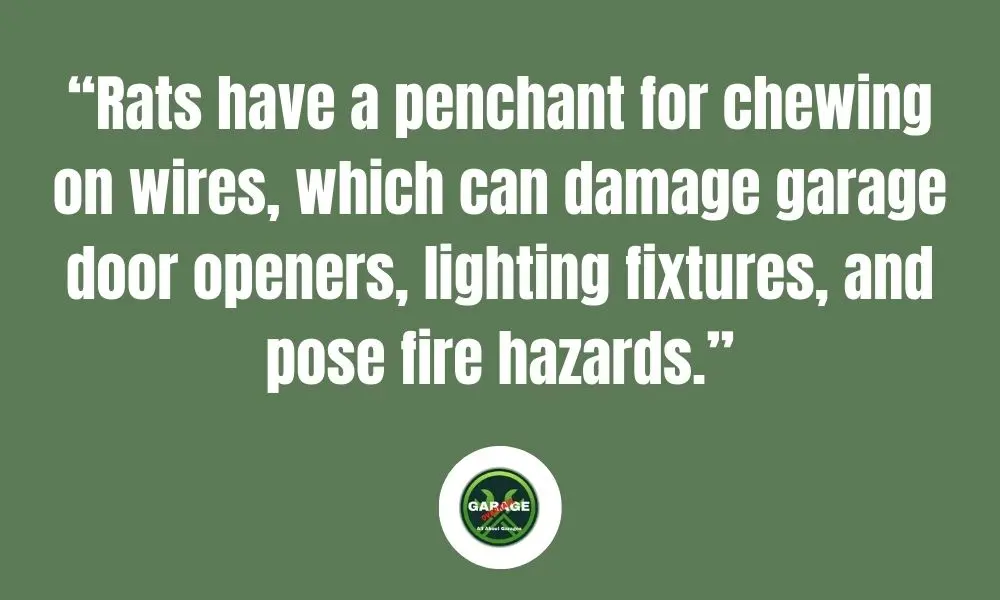
Insulation Damage
Insulation damage is often the work of pests seeking nesting material. Rodents, in particular, are known to tear apart insulation to build their nests, affecting your garage’s energy efficiency and potentially leading to more significant issues within your home’s walls.
Suppose you notice bits of insulation around your garage and an increase in energy bills. In that case, you may have bugs causing issues with your insulation.
Stored Items
The things you store in your garage are not safe from the ravages of pests. From clothing and documents to wooden furniture, pests like silverfish, moths, and beetles can wreak havoc.
These insects are attracted to natural fibers and paper, and their feeding habits can lead to irreversible damage.
Foundation Issues
Foundation issues may not be the first thing you think of with pests, but certain types, like ants and termites, can affect the very structure of your garage.
By burrowing into the ground and creating extensive networks, they can undermine the foundation, leading to cracks and instability.
If you suspect you have issues with termites, take immediate action to ensure they do not destroy the foundation of your garage.
Disease and Health Risks
Health hazards can come from the droppings and urine of rodents and other pests, contaminating your garage space. This can spread diseases and trigger allergic reactions, making the garage an unhealthy environment.
Exposure to rat urine is known to cause leptospirosis, a health condition that can cause death if not treated well. Flies can spread diseases can cause:
- dysentery,
- cholera, and
- typhoid fever.
Aesthetic Damage
Aesthetic damage is often the most visible impact of pests. Cobwebs, droppings, nests, and dead pests themselves contribute to a garage’s deterioration, making it an unsightly and unwelcoming space.
You may notice stains and marks on your garage wall or holes. There may also be bad and offending smells in and around your garage.
How To Remove Pests In Your Garage?
Removing pests from your garage can seem daunting, but with the right strategies, you can reclaim this space from unwelcome guests. Here are seven effective ways to rid your garage of pests and keep it pest-free.
Seal Entry Points
The first line of defense is to prevent pests from entering your garage. Inspect the walls, garage door, and windows for cracks or gaps. Use silicone caulk or foams to seal these openings.
Pay special attention to the garage door, ensuring it fits snugly when closed, leaving no room for pests to enter.
Regular Cleaning
A clean garage is far less attractive to pests. Remove clutter where bugs and rodents can hide or nest. Regularly sweep and clean the garage floors to eliminate food particles or residues that might attract pests.
Don’t overlook spider webs or nests in the corners and along the ceiling.
Proper Storage
How you store and organize items in your garage can significantly impact pest control. Avoid using cardboard boxes, as they attract pests like cockroaches and silverfish.
Instead, opt for sealed plastic containers. This keeps pests out and protects your belongings.
Use Traps
Traps can be an effective removal tool for rodents and larger insects. Place traps strategically around your garage, particularly along walls where pests are likely to travel. Check and clear these traps regularly to manage the pest population.
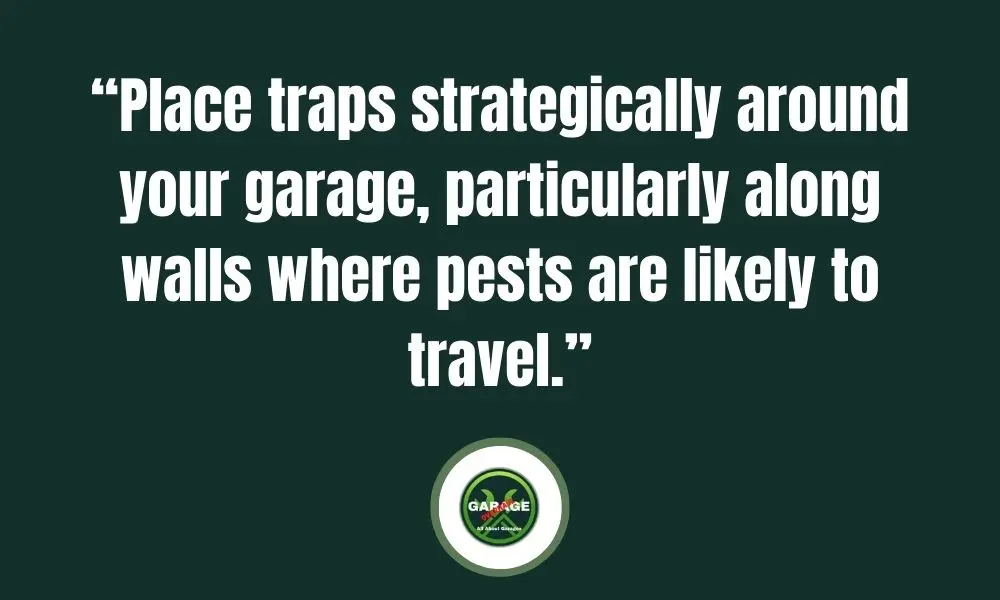
Maintain Your Garage Door
Regular garage door maintenance can help prevent pest infestations. Ensure that the garage door seals tightly and snugly when closed and that there are no gaps or tears in the sealing strips at the bottom and sides of the door.
Pest Control Products
You might need to resort to pest control products for more persistent pest issues. These can include sprays, baits, and granules designed to target specific pests. Always read and follow the product instructions and advice carefully to ensure safety and effectiveness.
Professional Pest Control
When DIY methods fall short, or if you’re dealing with a severe infestation, it’s time to call in the professionals. A pest control company can offer comprehensive solutions, employing strategies and treatments that are beyond the reach of most homeowners.
These experts can identify the types of pests you’re dealing with, their entry points, and the best course of action to eliminate them.
Implementing these pest control strategies can help you maintain a bug-free garage. Remember, consistency is key. Regular inspections and maintenance, combined with proactive pest control efforts, will keep your garage space clean, safe, and pest-free.
How To Make Sure Your Garage Door Keeps Pests And Bugs Out?
Ensuring your garage door is a formidable barrier against pests and bugs is crucial in maintaining a pest-free garage. Here are four practical ways to fortify your garage door against unwanted guests.
Seal Gaps and Cracks
The smallest gap or crack around your garage door can be an open invitation for pests. Inspect the entire perimeter of the door for any signs of daylight or drafts.
Use silicone caulk to seal small cracks and weather stripping for larger gaps. This not only keeps pests out but also improves energy efficiency.
Install Door Sweeps
A door sweep attached to the bottom of your garage door can block pests from entering. It’s particularly effective against crawling insects and small rodents that might try to squeeze under the door.
Ensure the sweep makes firm contact with the garage floor across the entire width of the door.
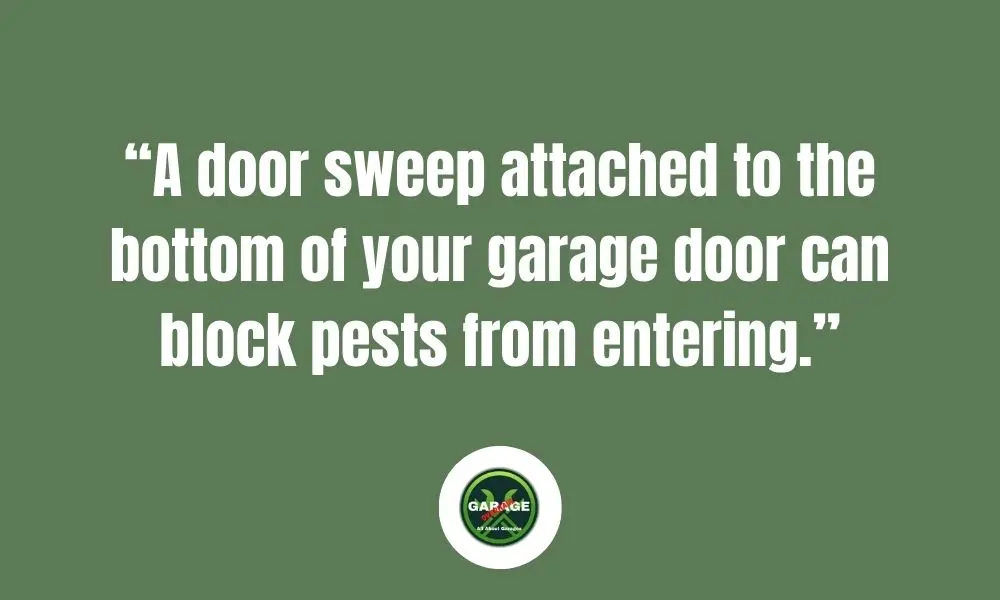
Regular Maintenance
Keeping your garage door in good working order is key to preventing pest entry. This includes inspecting and observing for wear and tear on seals and weather stripping and ensuring the door opener and closing mechanisms are functioning correctly.
Regular maintenance can identify and rectify potential entry points before pests take advantage.
Keep the Area Clean
The immediate area around your garage door should be free of debris, leaves, and standing water, which can attract pests.
Ensure that the garage floor and driveway are clean, and trim back any vegetation that touches the garage walls or door. A tidy exterior is less inviting to pests looking for a new home.
By implementing these strategies, you can significantly reduce the chances of pests making their way into your garage through the door. Keeping pests out requires vigilance and regular upkeep, but the payoff is a cleaner, safer garage space.
How To Keep Pests Out Of Garage: Bug-Free Garage
Keeping pests out of your garage is an ongoing effort that combines:
- diligent maintenance,
- strategic storage, and
- proactive pest control measures.
Sealing entry points, maintaining cleanliness, using appropriate storage solutions, deploying traps, ensuring your garage door is in top condition, and utilizing pest control products, are all key strategies.
By implementing these pest control steps, you can set up a less inviting environment for pests and protect your garage from potential infestations.
Remember, the goal is to create, and then maintain a clean, secure, and pest-free space that safeguards both your garage and your home.
Check out comprehensive guides on how to get rid of:
